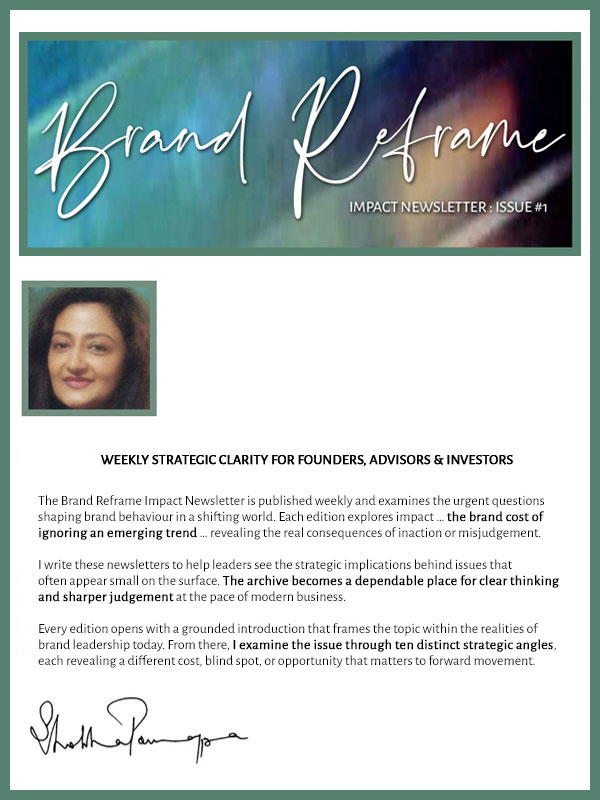
BY: SHOBHA PONNAPPA | BRAND BREAKTHROUGH STRATEGIST | 45 YEARS | 125+ CLIENTS
Brand scaling is the disciplined expansion of a brand’s reach, revenue, and operations without losing the core value that made it successful in the first place. It involves increasing market share, entering new segments, or launching additional products while ensuring that the customer experience, quality, and brand identity remain consistent. Scaling is not just about getting bigger … it’s about getting stronger in a way that compounds your impact.
In my work as a Brand Breakthrough Strategist, I have found that successful brand scaling is a careful balance between ambition and control. If you scale too quickly, you risk operational strain, diluted messaging, and cultural misalignment. Scale too slowly, and you leave opportunities on the table for competitors to seize. True scaling ensures that every new touchpoint strengthens the brand rather than stretching it thin.
We live in a marketplace where opportunities appear and vanish in record time. A well-prepared brand can seize these openings to grow without losing footing, while others struggle to respond. Scaling allows a brand to capture momentum, increase visibility, and improve operational leverage … creating efficiencies that lower costs and boost margins. The ability to scale quickly yet sustainably is now a competitive advantage in its own right.
However, scaling in the present context is not just about physical or digital expansion. It’s about ensuring that systems, culture, and market positioning can grow in harmony. Without that alignment, scaling can lead to burnout, declining customer loyalty, and a bloated cost base. Brands that scale with intent and structure find themselves more resilient and better equipped to weather market turbulence.
Strategic market expansion is the ability to identify and enter new markets where your brand can win. This could mean moving into a new geography, targeting a fresh audience segment, or diversifying your product line. The key is to scale where your strengths naturally align with the market’s needs, rather than chasing growth for its own sake.
Brands that master this foundation invest heavily in market intelligence before making a move. They use pilot launches, selective partnerships, and phased rollouts to test their assumptions before committing fully. By matching their capabilities to high-potential opportunities, they minimise risk while maximising impact.
Scalable infrastructure is the operational backbone that allows a brand to handle increased demand without compromising quality or customer experience. It includes systems, processes, technology, and supply chain capacity that can flex and grow in response to market changes.
Brands that invest early in scalable infrastructure can respond faster, fulfil reliably, and innovate more easily. They avoid the chaos of scrambling to catch up once demand has already surged. Whether it’s automation, cloud-based platforms, or agile fulfilment networks, scalable infrastructure ensures that growth is smooth, not bumpy.
Cultural alignment ensures that as a brand grows, its internal culture remains strong and coherent. Scaling often requires new hires, new offices, or new partners … each of which can introduce cultural drift if left unmanaged. Maintaining a clear set of shared values and behaviours keeps teams aligned no matter how large or geographically dispersed they become.
Brands with strong cultural alignment integrate onboarding, training, and leadership development into their scaling plans. They treat culture as an asset to be scaled alongside revenue, making sure every new team member becomes a carrier of the brand’s ethos, not just a performer of tasks.
Brand consistency means delivering the same promise, tone, and quality across every channel and customer touchpoint, even as the number of these touchpoints grows. This prevents brand fragmentation and ensures that every interaction reinforces the same core story.
Brands that achieve consistency at scale use clear guidelines, centralised brand management tools, and regular audits to keep messaging, design, and customer experience aligned. They understand that one off-brand campaign or misaligned customer interaction can erode trust faster than it was built.
Scaling starts with clarity. You need to define not just where you want to grow, but what parts of your brand must remain unchanged in the process. This involves identifying the core strengths that customers value most and ensuring those remain untouched during expansion.
You should also embed scalability into your business model from day one. That means choosing systems, suppliers, and channels that can grow with you, and designing your organisational structure for flexibility. The earlier you bake scalability into your DNA, the easier it becomes to grow without disruption.
Sustaining scaling means continually matching your growth pace to your capacity. This requires regular health checks on infrastructure, culture, and market positioning to ensure you are not outgrowing your ability to deliver. Scaling should never compromise customer experience, because reputation is a brand’s most scalable asset.
It also means diversifying your growth engines so you’re not dependent on one market, one product, or one channel. By balancing multiple streams of opportunity, you create a scaling model that is less vulnerable to sudden downturns and more capable of compounding gains.
One common pitfall is mistaking speed for success. Growing too fast without the right infrastructure or cultural stability often leads to operational bottlenecks, inconsistent quality, and staff burnout. These issues can reverse gains just as quickly as they were achieved.
Another pitfall is neglecting brand consistency during rapid expansion. As new channels, campaigns, and team members multiply, small deviations can snowball into a fractured brand identity. Once lost, consistency is difficult to recover, and the damage to trust can be long-lasting.
A fast-growing skincare brand saw strong domestic demand and wanted to enter three international markets within a year. Instead of launching everywhere at once, I guided them through a phased rollout, starting with one test market. This allowed them to refine logistics and marketing before replicating the model, resulting in a 45% faster ROI in subsequent launches.
A software-as-a-service platform faced customer support strain as new sign-ups tripled in six months. I helped them implement a tiered support model with self-service tools and AI-assisted chat, reducing response times by 60% and freeing up human agents for complex queries, without hiring at the same pace as growth.
When a regional coffee chain began franchising, it risked losing the community-driven culture that defined it. I worked with them to create a “culture kit” that every franchisee had to adopt … including hiring guidelines, event playbooks, and staff rituals … ensuring a consistent brand feel in all new locations.
A popular fitness influencer wanted to scale from subscriptions alone to include branded merchandise, retreats, and corporate programs. By sequencing these launches and cross-promoting each one to the existing community, I helped them grow revenue by 65% in a year without diluting the core service.
A luxury jewellery retailer wanted to scale without losing its high-touch customer experience. I helped them design an e-commerce store with virtual concierge services and video consultations, allowing them to scale globally while preserving the personalised service that defined their brand.
A hardware startup faced rising demand but feared quality issues from increasing output. I helped them source multiple manufacturing partners and create rigorous quality benchmarks, enabling them to triple production without a single warranty claim spike.
The biggest misconception is that scaling is purely about increasing output or entering new markets. True scaling requires maintaining brand integrity and customer experience as you grow, which often demands stronger systems, clearer positioning, and more selective opportunities. Without these, growth can dilute your brand’s value instead of amplifying it. Sustainable scaling balances ambition with operational and cultural readiness.
Signs of readiness include consistent demand, strong customer retention, a clear market position, and operational systems that can handle increased volume without breaking. Financial stability and a proven, repeatable sales process are also important indicators. If your growth is currently driven by founder hustle rather than systems, you may not yet be ready. Scaling prematurely can create strain that erodes both customer satisfaction and profitability.
Leadership is critical because scaling often requires shifting from hands-on execution to vision-setting, culture-shaping, and strategic oversight. Leaders must learn to delegate effectively, hire the right people, and inspire alignment across expanding teams. Without strong leadership, scaling efforts can splinter into inconsistent execution and internal conflict. A clear, unified direction ensures that growth strengthens the brand rather than scattering it.
In most cases, yes … it’s wise to establish a solid, profitable base in your home market before taking on the complexities of international expansion. Domestic scaling allows you to refine systems, build financial reserves, and strengthen your brand identity. International growth brings challenges like cultural differences, regulatory variations, and logistical costs, which are easier to navigate when your core operations are rock solid. Skipping this stage can stretch resources too thin.
Maintaining personalisation at scale means embedding customer understanding into processes and technology, rather than relying solely on individual touchpoints. Use data and automation to segment and customise communications, while empowering teams to make decisions that reflect your brand values. Standardising the why and how behind customer care helps keep experiences warm and relevant. The goal is to grow reach without feeling generic.
The most common mistake is chasing growth for its own sake without ensuring the foundation can support it. This often leads to cash flow issues, declining quality, and burnout within the team. Scaling should be paced according to capacity, demand, and profitability rather than arbitrary timelines. The brands that win in the long term are those that scale in alignment with their market strength and operational readiness.
Explore Brand Scaling Risks … Real Cases & Fixes
Case Studies
FAQ Insights

"One BIG IDEA can turn brand stagnation into unstoppable movement. Spots are limited each week ... book your breakthrough session now."
Shobha Ponnappa
My Definitive Guides to Other Critical Branding Concepts
Download the 14-case collection and receive weekly insights to strengthen your strategic judgement.
Get my free Case Studies Compendium. Real transformations, clear strategic shifts, and practical ways brands regain traction.

You’ll also get my fortnightly Brand Reframe newsletter. with smart insights, distilled thinking, and focused ideas to help your brand.

Just fill in the form to join. Be part of our circle thriving on brand clarity, good judgement, and several game-changing tips.